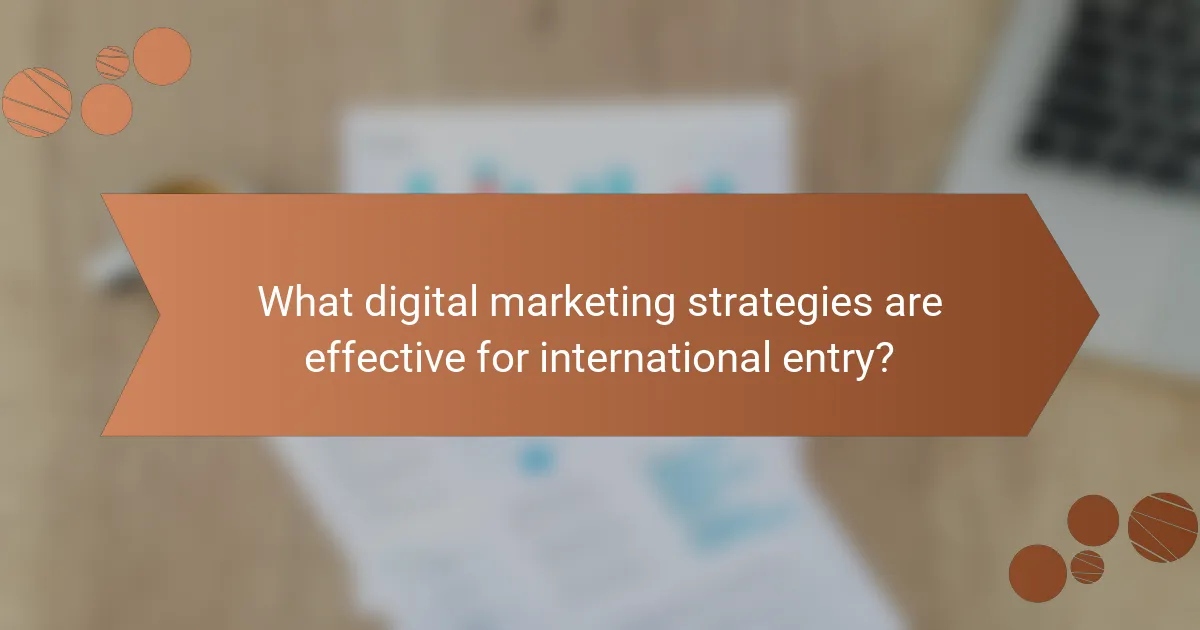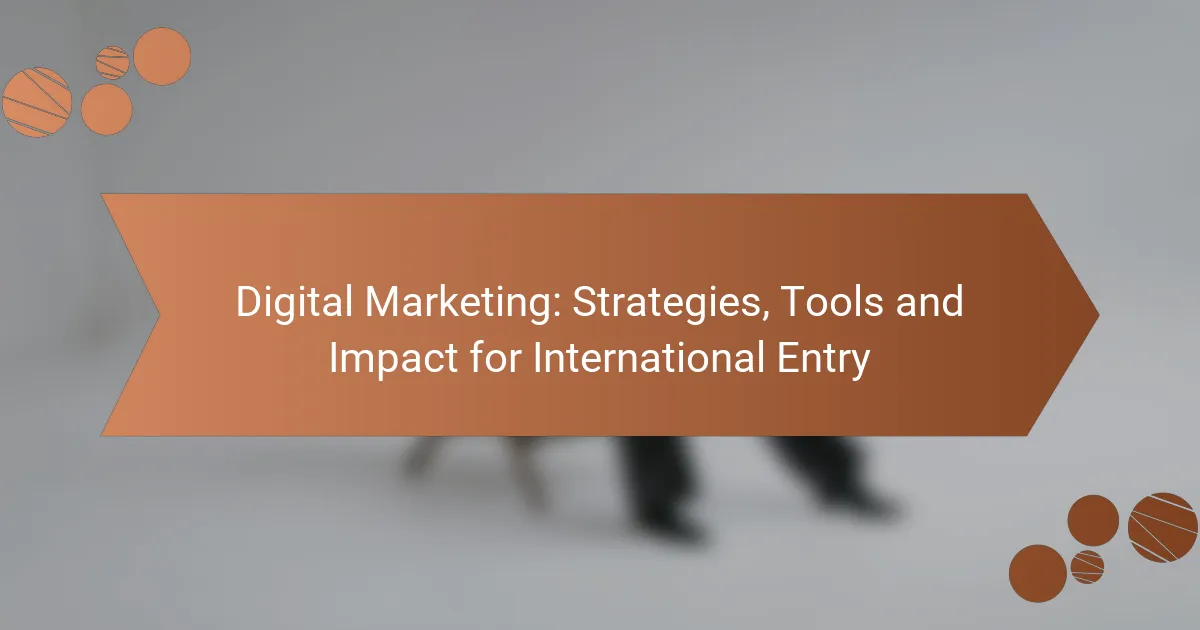Digital marketing plays a crucial role in facilitating successful international market entry by employing strategies such as content localization, search engine optimization, and social media marketing. By utilizing the right tools and focusing on key performance metrics, businesses can effectively engage with local audiences and adapt their marketing efforts to meet diverse cultural and regulatory needs.

What digital marketing strategies are effective for international entry?
Effective digital marketing strategies for international entry include content localization, search engine optimization, social media marketing, email marketing campaigns, and pay-per-click advertising. These strategies help businesses connect with local audiences, improve visibility, and drive engagement in new markets.
Content localization
Content localization involves adapting marketing materials to fit the cultural, linguistic, and contextual nuances of a target market. This means translating not just words, but also considering local customs, idioms, and consumer preferences. For example, a campaign that works in the U.S. may need significant adjustments to resonate in Germany.
Key steps include researching local trends, using native speakers for translations, and testing content with local audiences. Avoid direct translations that may misinterpret cultural references, as this can lead to misunderstandings or even offend potential customers.
Search engine optimization
Search engine optimization (SEO) is crucial for improving visibility in local search results. This involves optimizing website content with relevant keywords, local backlinks, and ensuring the site is mobile-friendly. For international markets, consider using local domain extensions (like .de for Germany) to enhance credibility.
Focus on local search behaviors, which can vary significantly. Tools like Google Keyword Planner can help identify popular search terms in different regions. Regularly updating content and monitoring performance through analytics is essential to stay competitive.
Social media marketing
Social media marketing allows brands to engage directly with local audiences through platforms popular in specific regions. Understanding which platforms are favored—such as Facebook, Instagram, or WeChat—is vital for effective outreach. Tailor content to fit the platform’s style and user expectations.
Creating localized campaigns that reflect local events, holidays, or trends can enhance engagement. It’s also beneficial to interact with followers by responding to comments and messages promptly, fostering a sense of community and trust.
Email marketing campaigns
Email marketing campaigns can be highly effective for nurturing leads and maintaining customer relationships in new markets. Personalization is key; segment your audience based on local preferences and behaviors to send targeted messages. Use local language and references to make emails more relatable.
Consider local regulations, such as GDPR in Europe, when collecting and using email addresses. A/B testing different subject lines and content can help determine what resonates best with your audience, leading to higher open and conversion rates.
Pay-per-click advertising
Pay-per-click (PPC) advertising allows businesses to target specific demographics in international markets effectively. Platforms like Google Ads and Facebook Ads enable precise targeting based on location, interests, and behaviors. This can be a cost-effective way to gain visibility quickly in a new market.
When setting up PPC campaigns, ensure that ad copy and landing pages are localized. Monitor performance closely and adjust bids and targeting based on what works best. Consider starting with a small budget to test different approaches before scaling up your efforts.

How to choose the right digital marketing tools for global reach?
Selecting the right digital marketing tools for global reach involves understanding your target markets and the specific needs of your business. Focus on tools that enhance visibility, engagement, and analytics across various regions, ensuring they are adaptable to local preferences and regulations.
Market analysis tools
Market analysis tools help businesses understand consumer behavior, market trends, and competitive landscapes in different countries. Tools like Google Analytics, SEMrush, and Statista provide valuable insights into demographics, preferences, and purchasing patterns.
When choosing a market analysis tool, consider factors such as the regions you are targeting, the depth of data required, and the tool’s ability to integrate with other platforms. For example, if you are entering the European market, ensure the tool complies with GDPR regulations.
SEO optimization platforms
SEO optimization platforms are essential for improving your website’s visibility in search engines across various countries. Tools like Ahrefs, Moz, and Yoast SEO help optimize content, track keyword performance, and analyze backlinks tailored to local search engines.
When selecting an SEO tool, prioritize those that offer multilingual support and localized keyword research. For instance, if targeting Spanish-speaking countries, ensure the platform can analyze keywords in Spanish and provide insights specific to those markets.
Social media management software
Social media management software enables businesses to manage their online presence across multiple platforms efficiently. Tools like Hootsuite, Buffer, and Sprout Social allow for scheduling posts, monitoring engagement, and analyzing performance metrics globally.
Choose a social media tool that supports the platforms popular in your target regions. For example, if entering markets in Asia, consider tools that integrate with WeChat or Line. Additionally, ensure the software can handle multiple languages and time zones to optimize your global campaigns.

What are the key metrics to measure digital marketing success internationally?
Key metrics for measuring digital marketing success internationally include conversion rates, website traffic sources, and customer engagement levels. These metrics provide insights into how effectively a marketing strategy resonates across different markets and cultures.
Conversion rates
Conversion rates indicate the percentage of visitors who take a desired action, such as making a purchase or signing up for a newsletter. For international markets, it’s crucial to analyze conversion rates separately for each region to understand local preferences and behaviors.
Consider factors like currency differences and cultural nuances that may affect purchasing decisions. A conversion rate of 2-5% is often considered average for e-commerce, but this can vary widely based on industry and market maturity.
Website traffic sources
Website traffic sources reveal where your visitors are coming from, including organic search, paid ads, social media, and referrals. Understanding these sources helps identify which channels are most effective in different countries.
For instance, in some regions, social media might drive a significant portion of traffic, while in others, organic search could be more effective. Regularly analyzing traffic sources allows for better allocation of marketing resources and tailored strategies for each market.
Customer engagement levels
Customer engagement levels measure how actively users interact with your content, including metrics like time spent on site, pages per session, and social media interactions. High engagement often correlates with higher conversion rates and customer loyalty.
To enhance engagement, consider localized content that resonates with cultural values and interests. Tools like heatmaps can help visualize user behavior, allowing for adjustments to improve user experience and retention across different international markets.

What challenges do e-commerce businesses face in international markets?
E-commerce businesses encounter various challenges when entering international markets, including cultural differences, legal compliance issues, and payment processing hurdles. Understanding these obstacles is crucial for developing effective strategies to succeed globally.
Cultural differences
Cultural differences can significantly impact marketing strategies and customer engagement. Businesses must adapt their messaging, branding, and product offerings to resonate with local customs and consumer preferences.
For example, colors, symbols, and even product names can carry different meanings across cultures. Conducting thorough market research and engaging local experts can help mitigate misunderstandings and foster better connections with international audiences.
Legal compliance issues
Legal compliance is a critical concern for e-commerce businesses operating internationally. Different countries have varying regulations regarding consumer protection, data privacy, and taxation, which can complicate operations.
For instance, the General Data Protection Regulation (GDPR) in the European Union imposes strict rules on data handling. Companies must ensure they comply with local laws to avoid hefty fines and legal complications.
Payment processing hurdles
Payment processing can present significant challenges due to the diversity of payment preferences and methods across countries. Businesses need to offer multiple payment options, including credit cards, local e-wallets, and bank transfers, to cater to different markets.
Additionally, currency conversion and transaction fees can affect pricing strategies. It’s essential to choose reliable payment processors that support international transactions and provide transparent fee structures to enhance customer trust and satisfaction.

How to develop a digital marketing budget for international expansion?
To develop a digital marketing budget for international expansion, start by assessing your overall business goals and the specific markets you wish to enter. Consider the costs associated with various digital marketing strategies, resource allocation, and expected returns on investment to create a comprehensive budget plan.
Cost analysis of strategies
Conduct a thorough cost analysis of different digital marketing strategies such as social media advertising, search engine optimization (SEO), content marketing, and pay-per-click (PPC) campaigns. Each strategy may have varying costs depending on the target market; for instance, PPC rates can differ significantly between countries.
Estimate both fixed and variable costs associated with each strategy. Fixed costs might include software subscriptions, while variable costs could involve ad spend and freelance services. Aim for a budget that allows flexibility to adapt to market responses.
Allocation of resources
Allocate resources based on the effectiveness and reach of each digital marketing strategy. For instance, if social media engagement is high in a particular market, consider investing more in that channel. A common approach is to allocate around 30-40% of your budget to the most promising strategies based on your cost analysis.
Ensure that your team has the necessary skills to execute the strategies effectively. This may involve hiring local experts or training existing staff to understand cultural nuances and market dynamics in the target regions.
ROI projections
Projecting return on investment (ROI) is crucial for justifying your digital marketing budget. Use historical data from similar campaigns to estimate potential returns, keeping in mind that international markets may have different conversion rates and customer behaviors.
Establish clear metrics to measure success, such as customer acquisition cost (CAC) and lifetime value (LTV). A common benchmark is to aim for an ROI of at least 3:1, meaning for every dollar spent, you should expect to earn three in return. Regularly review and adjust your projections based on real-time performance data.



